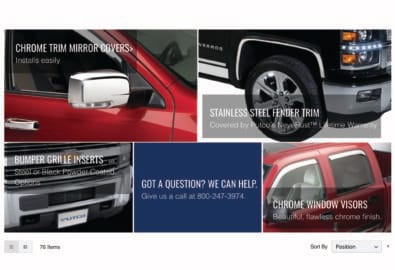
The Tech & Trends Shaping Automotive in 2023

The automotive industry is amid a period of change and challenges. Supply chain issues continue to trouble manufacturers, while dealers face rising costs and a growing regulatory landscape. Meanwhile, the industry appears to be in transition toward a bigger focus on electric vehicles (EVs), digitalization, and a mix of other technological innovations, making it hard for some companies and consumers to keep up.
In this blog post, we will highlight the answer to this exact question and how this is similar to other disruptions we have seen in the past – think Nokia and Apple.
The Top Tech Disruptors
The automotive industry is at a crossroads where the vehicle itself and consumer experiences are rapidly transitioning from physical to digital. More and more, consumers are shopping online to educate themselves, compare features and prices and also make the major investment of purchasing totally online. To capitalize on these disruptions, automakers will need to shift from their conventional, disconnected, and analog manufacturing methods to a connected and digitized environment.
Strict Regulations: New regulations and testing approvals are pushing traditional automakers to acquire or collaborate with innovative autonomous start-ups. For instance, many states and localities, such as the EPA and the California Air Resources Board, have upped their emissions standards, which immediately impacts your bottom line. In addition, the kinds of vehicles that can be designed to reduce emissions will be costly both in time and money. These incentives will further push manufacturers to include more electric and hybrid cars in their fleets and set the stage for rapid competitive consolidation. In other words, strap up because there’s a massive disruption ahead, and Tesla is winning the race. Consumers need to know the total cost of long term ownership of these vehicles and how it also impacts their bottom line.
Batteries and Motors: The most prominent disruptive trend has to be the innovations in the past couple of years in battery and motor technology. Lithium batteries and electric motors are not a new concept or technology; however, they, along with electric motors, will soon become products every company will try to recreate a better version of, almost like the individual parts of smartphones or PCs. Customers are more likely to look at who makes the best batteries than who brought about the use of lithium batteries. In around a decade, Tesla could own 15% of worldwide EV battery production, which will only give a minor competitive advantage. Likewise consumers need to know the value and life of these new batteries and motors–but how do they learn?
Increased cutting-edge production: Modern technologies are reshaping how the automobile industry manufactures cars. One such breakthrough technology is 3D printing to make vehicle parts. Additive manufacturing or 3D printing is an excellent source of product innovation. Metal 3D printing is already becoming mainstream, and this is just the beginning of what is to come in the automotive industry.
Augmented reality: Auto giant Toyota has joined forces with some digital transformation companies to create an augmented reality system that requires no mobile application and enables consumers to get to know the car models without even setting foot in the brand showroom. Using VR capabilities, auto companies can allow consumers to see inside and outside their potential new model and hear authentic sound effects with 360 degrees. Even on websites like TrueCar and Edmunds, all pertinent buying information is available in a second and at the click of a button. Another AR innovation that will take consumers by storm is displaying information on windshields. This technological safety advancement will allow drivers to process important data without taking their eyes off the road.
Internet on things (IoT): Used to describe the ever-growing networks of physical objects that are online, connected, and capable of communicating and sharing information with us and with each other. The total number of Internet of Things (IoT) devices is projected to surpass 43 billion by 2023. As a result, enterprises have begun to adapt to this growing imperative for connectivity, from our homes to smart TVs, connected kitchen appliances, smart alarm systems, and more. The number of businesses deploying IoT technologies has nearly doubled in less than a decade. Still, the pace of past evolution doesn’t compare to what we’ll see in the near future, especially in the automotive industry.
EV pay-per-mile vehicles: We expect companies that develop new, innovative pay-per-mile users-based models, especially in the commercial vehicles and buses space, to attract huge investments. Even during the most challenging periods of the pandemic, EV start-ups continued to pull in sizable funding investments. By showing us carbon-free ways to transform how people and goods are transported, backed by low CAPEX and lifecycle total cost of ownership models, they have put themselves in a position of strength.
Software Integration: Another significant disruption to the auto industry is Tesla and how it’s proving its autonomy of innovations to be the best in the industry. For instance, they are responsible for creating a single integrated computer system that controls their vehicles. Creating a system designed by the combination of separate incompatible computer systems from different suppliers could revolutionize the way Tesla and other companies who want to keep up with this competitive advantage build their products. In addition, Tesla is trying to perfect its Autopilot system to make it the best in the field; however other companies, such as Waymo, are already expanding self-driving cars to public transit. So the question is, how well does your autonomy need to be? How many companies could achieve that? Not to mention that data systems are changing daily, and every innovation must adapt to them, making it hard to keep up.
Evolving Customer Behavior
Current ecological, social, and technological trends are encouraging innovative manufacturers to offer consumers something much more than a typical metal box powered by engines. Carmakers are also showing interest in making good cars on the road and an enclosed space with high-end technology. For many years, carmakers were primarily focused on enhancing manufacturing to become more efficient at scale; the future is about redefining the role of the vehicle.
Consumers are looking for environmentally-friendly vehicles: People’s quest to search for environmentally-friendly cars is increasing. Green earth is a new concept that is attracting wide attention. Moreover, recent wildfires and glacier melting incidents have triggered people to focus on climate change. Henceforth, people look for electric vehicles (EVs) to minimize carbon emissions.
Demand for luxury/premium: Take trucks here as an example. Most people used to associate trucks with off-roading and rugged work, but those are assumptions of the past. Over the years, trucks have become more than that, with consumers preferring to buy luxury and power trucks as a status symbol. In addition to power, luxury trucks have features like extra towing capabilities, spacious seating, panoramic sunroof, rear-seat touchscreen entertainment, advanced safety features, and motorized tailgate and running boards that maximize comfort and style.
Spike in millennial purchasing habits: While many think millennials are not buying cars, the data available tells a different story. In the first quarter of 2018 alone, millennials accounted for all new car sales growth in the Northern American auto industry, with a 6.45% growth in the same period. This statistic has drastically increased since then, as more millennials buy cars when triggered by life-changing events such as switching jobs, getting married, or having children. Consider this statistic when marketing and focus targeted messaging on this segment.
Consumers doing online research: Buying a car is not a task most consumers look forward to, as it can be stressful and time-consuming. Still, since mobile phones have become a part of everyday life, it is easy to look for everything online, vehicles included. A report unravels that eight in ten car buyers use online sources as part of their vehicle purchase process. Moreover, of all online resources, automotive marketplaces are the most popular source used by 77% of new and used buyers. Insert Carvana, who jumped on this opportunity and changed the customer experience by giving power back to customers and letting them find their perfect car from their homes without having to haggle with salespeople. Online does not only mean a Chat bot feature but a real person and toll-free number to connect with for a better experience.
Disdain for the Retail Experience
For most people, buying a car is the second-biggest purchase they will make in life. And while it’s an exciting milestone, many also find it to be full of anxiety and time-consuming. And as more and more consumers discover that they can buy a new car (or leasing?) from the comfort of their home – with voluminous information available about vehicles they’re considering – they’re unlikely to ever return to the old way of doing business. The ability to negotiate with multiple dealers simultaneously without the pressure of the showroom and the time spent going from dealer to dealer will likely become an expectation. Dealerships that adapt will thrive, while those that don’t, will suffer.
How to adapt to DTC purchasing behavior
Unfortunately, no silver bullet can overcome the traditional automotive purchase model. However, there are still significant opportunities for automobile marketers to get up to speed with direct-to-consumer automotive in incremental ways:
- One significant DTC opportunity is selling aftermarket parts, which offers big margins and comes directly from the manufacturer.
- End-user services related to data connectivity or insurance and financing provider, may provide other possibilities.
- Replicating showrooms and sales interactions online.
The digital transformation of some aspects of the buying process is a starting point for building and sustaining connections directly with consumers.
The Future of Car Retail
As the world has already approached digital transformation, the automotive industry is increasingly making technological breakthroughs to stay relevant in today’s competitive landscape. From autonomous vehicles to connected cars and augmented reality dashboard displays to full integration with phones and smartwatches, the automotive industry is on the cusp of innovation, delivering users an enhanced automotive car experience.
When it comes to this experience, Tesla and Carvana stand on top. Why are customers so fanatic about these brands? Is it their sleek design, innovative delivery features, or eco-friendly nature? It is all those things and the forward-thinking, innovative individuality they provide to their customers; which often leads to incredible loyalty and growth. Let’s dive a bit deeper into this.
The hallmark of Tesla’s personalization efforts is its driver profiles. Each driver can change their settings with the single push of a button. For example, instead of manually adjusting things like the wheel and mirror location, Tesla vehicles can make those changes automatically based on who is driving. Other manufacturers may change the seat location setting based on which key is used to open the car door, but Tesla driver profiles go beyond typical car personalization to adjust things like suspension, braking, lights, radio presets, and even driving style to match each user.
Carvana also has a competitive advantage because they meet its customers where they are and provide a solution to one major consumer pain point. They replaced consumers’ time-consuming car dealership visits with a virtual experience. Using their patented 360-degree photo technology, they captured vehicle details from every angle, allowing consumers to browse for a car and explore its features and any imperfections directly from their website or app. And they don’t stop there. They provide customers with the option to either pick up their car or have it delivered to their home. A great option for ecommerce business local or long distance to have this choice based on where they are and how quickly needed.
Simply put, both of these manufacturers have a solid understanding of who their customers are. By understanding each customer, what they are looking for in a driving experience, and why they decided to shop with them, both companies can tailor the experience and change how the car drives to best meet their needs. For instance, a busy professional with a long commute will have different needs and, therefore, a different driving experience than a mom driving her kids around town. In addition, by staying in tune with data, Tesla and Carvana can regularly update their digital offerings, finetune their software and build experiences and features that resonate with each user.
Bringing it all together
As you can see, the decade ahead is going to be very interesting and exciting for the automotive industry, and for you as well. And we’ve only scratched the surface of all of the new developments occurring and forthcoming. Maybe we’ll see Google, Samsung, or Apple enter the market in the future. Maybe cars will begin gathering data on traffic conditions, air quality, and the weather.
Are you ready to capitalize on these disruptions and shift your current manufacturing and customer sales methods to increase your capital and gain a competitive advantage? Schedule a call with a member of our team today.
Drop Us a Line At:
email: [email protected] and [email protected]
Or, if you prefer an old-fashioned phone call:
Phone (USA): (513) 469-3346
4665 Cornell Rd. Suite 255
Cincinnati, OH 45241





































